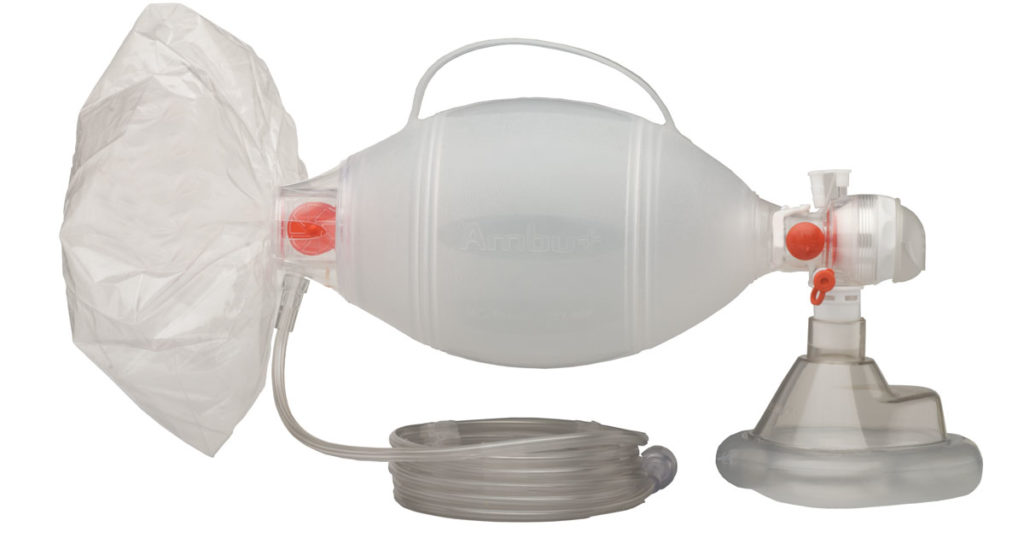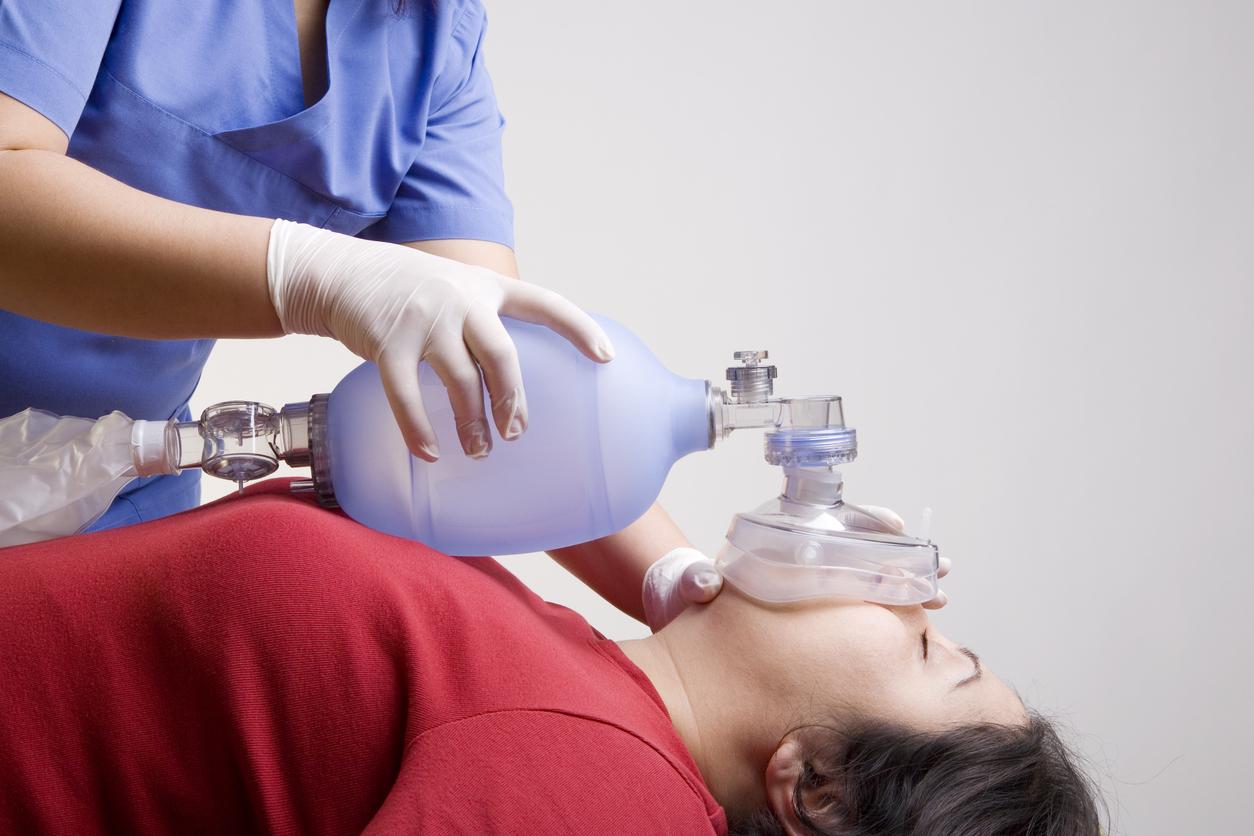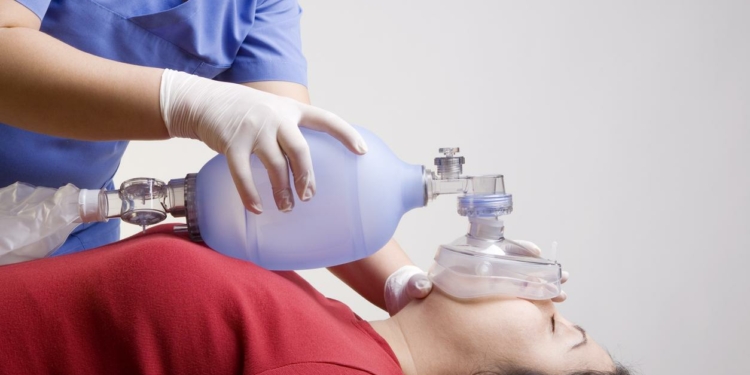What exactly is an AMBU bag, and why does it matter? The AMBU bag allows emergency responders and healthcare professionals to manually pump oxygen into a patient’s lungs when their normal breathing functions have been disrupted. The AMBU bag is a staple in emergency rooms, ambulances, and trauma centers because it can mean the difference between life and death during those critical first minutes of providing care. Read on to learn more about an Ambu Bag and how it is used.
What Is an AMBU Bag?

An AMBU bag, bag valve mask (BVM), or self-inflating bag is a manual resuscitator used to provide ventilation assistance to patients who are not breathing or struggling to breathe. AMBU bag stands for Artificial Manual Breathing Unit; it is a hand-held device used to provide ventilation assistance to a patient who is not breathing or struggling to breathe on their own.
This medical device consists of a self-inflating bag attached to a face mask. By squeezing the bag, you deliver oxygen to the patient. Releasing the bag allows the patient to exhale passively. Repeating this process manually inflates and deflates the lungs, providing lifesaving ventilation. AMBU bags come in different sizes for adults, children, and infants. They are a crucial piece of emergency equipment used by paramedics, lifeguards, and hospital staff when someone suffers respiratory failure or cardiac arrest. The portability and simplicity of an AMBU bag make it ideal for CPR in an emergency when other equipment may not be available.
In short, an AMBU or Ambu bag is a manually operated bag valve mask used to pump oxygen into a patient’s lungs through a face mask. It’s a lifesaving medical device that can keep someone breathing during a medical emergency until further treatment is available.
How does AMBU Bags Work
An AMBU bag, or artificial manual breathing unit, is a hand-operated resuscitator used to provide ventilation to a patient who is not breathing or struggling to breathe. An AMBU bag consists of an air-filled bag, a face mask, and a one-way valve; by squeezing the bag, you push air through the attached mask and into the patient’s airway, inflating their lungs and providing lifesaving oxygen until they can breathe on their own or are connected to a mechanical ventilator.
Using an AMBU bag, a rescuer can provide lifesaving ventilation to a patient in respiratory distress until emergency responders arrive. For the best chance of survival, ventilation should be provided as soon as possible. An AMBU bag is a simple but essential emergency tool that can mean the difference between life and death.
The History and Origins of the AMBU Bag
The AMBU bag, or Artificial Manual Breathing Unit, was created in 1953 by Hesse and Danish anesthesiologist Henning Ruben. Originally called the Ambu bag, it was designed as a manual resuscitator to help patients breathe during surgery when muscle relaxants made spontaneous breathing impossible.
The AMBU bag consists of a self-inflating bag attached to a face mask. By manually compressing the bag, the rescuer can deliver oxygen to the patient on demand. This allows the rescuer to control the volume, rate, and pressure of ventilation for the patient. The AMBU bag is a crucial emergency tool that has saved countless lives when patients experience respiratory distress or arrest.
Over time, the AMBU bag evolved to include additional features like reservoir bags, valves, and monitoring ports. It continues to be a staple in emergency medicine, used by first responders, hospitals, and the military. This simple but ingenious device has had an enormous impact, allowing basic life support ventilation for people around the world.
AMBU Bag Features and Design
The AMBU bag has many important features and components in its design to function as a manual resuscitator properly.
Valve system
The AMBU bag has a one-way valve system that allows air to enter the bag but not escape as you compress the bag. This ensures the air is directed to the patient.
Reservoir bag
The collapsible reservoir bag stores air on compression so it can be delivered to the patient’s lungs on release. This provides a steady, controlled flow of air.
Patient valve
The patient valve is a one-way valve that opens when the resuscitator bag is compressed to allow air to flow to the patient, then closes when the bag refills with air to prevent the patient from exhaling back into the AMBU bag.
Masks and airways
The AMBU bag comes with masks and airways of different sizes to properly seal over a patient’s mouth and nose, or just the nose, to provide ventilation. The masks and airways create an airtight seal for effective CPR.
Oxygen inlet
An oxygen inlet allows supplemental oxygen to be connected to enrich the air being delivered to the patient. This provides lifesaving oxygenated air during resuscitation.
Pressure release valve
A pressure release valve opens if too much pressure builds up in the system to prevent barotrauma. A pressure valve releases excess pressure to keep airway pressures at a safe level.
PEEP Valve
Some advanced ambu bags may also have PEEP (positive end-expiratory pressure) valves, which help keep the airways open and improve oxygenation.
Transparent design
Most Ambu bags are transparent, which allows the user to see the patient’s chest rise and fall during ventilation.
Carrying handle
A sturdy carrying handle allows the AMBU bag to be easily transported and positioned for optimal use during an emergency.
The thoughtful design and lifesaving features of the AMBU bag have made it an essential piece of emergency rescue equipment for over 60 years. Proper use of this manual resuscitator has saved countless lives.
Uses of AMBU Bags
An AMBU bag, or manual resuscitator, has many important uses in emergency medicine and resuscitation. An AMBU bag is used during cardiopulmonary resuscitation (CPR) or if a patient’s breathing has slowed or stopped. It can provide 100% oxygen to a patient until emergency responders arrive or a ventilator is set up. It is a temporary way to get oxygen into the lungs of someone who cannot breathe on their own.
Here are some of the uses of AMBU Bag:
Ventilation
The main purpose of an AMBU bag is to manually ventilate a patient who is not breathing or struggling to breathe on their own. By squeezing the AMBU bag, you deliver oxygen to the patient’s lungs. This can keep a patient oxygenated until emergency responders arrive or during transport to a hospital.
Resuscitation
An AMBU bag is a key piece of equipment used during cardiopulmonary resuscitation (CPR). Along with chest compressions, the AMBU bag is used to provide rescue breaths to a patient in cardiac arrest. The oxygen and ventilation provided by the AMBU bag are critical for resuscitation and increasing the chance of survival.
Other Uses
AMBU bags also have other uses like:
- Providing oxygen before intubation
- Assisting ventilation during procedures
- Suctioning airways
- Helping patients with acute respiratory distress
- Anesthesia Induction
Whether at the scene of an emergency or in a hospital setting, an AMBU bag is a simple but lifesaving piece of equipment. Proper use of an AMBU bag plays an important role in providing temporary ventilation and oxygenation for patients in respiratory distress.
Where to Buy High-Quality AMBU Bags
There are several places where you can purchase high-quality AMBU bags:
Online Retailers
- Amazon
- JIJI
Medical Supply Stores
If you prefer to see the AMBU bags in person before purchasing, check your local medical supply stores, like:
- Hospital
- Pharmacy
These stores allow you to inspect the quality and features of different AMBU models so you can find one suited to your needs. Their knowledgeable staff can also guide the proper use and care of the equipment.
Emergency Response Organizations
Some fire departments, ambulance services, and disaster relief organizations purchase AMBU bags and other emergency gear in bulk and resell them to individuals and smaller organizations. Contact groups in your local area to inquire about any units they may have available for purchase. This can be an affordable way to obtain a high-quality AMBU bag.
How to Assemble and Use an AMBU Bag

An AMBU bag, or artificial manual breathing unit, is a hand-held device used to provide respiratory support to a patient who is not breathing or struggling to breathe.
To assemble and use an AMBU bag follow these steps:
- Assemble the Ambu bag and ensure it is properly disinfected.
- Ensure the patient’s airway is clear of mucus and not blocked by any foreign bodies or their tongue.
- Tilt the patient’s head back slightly so that the nose is up. You can place something under their neck or shoulders to keep them in the right position, like a pillow.
- Attach the face mask to the bag. Make sure it is securely connected and sealed.
- Connect the oxygen inlet to an oxygen tank and turn on the oxygen flow. This will fill the bag with oxygen to assist the patient’s breathing.
- Place the mask over the patient’s mouth and nose, creating an airtight seal.
- Squeeze the bag with both hands to push oxygen into the patient’s lungs. Squeeze the Ambu bag hard enough to make the patient’s chest rise just as it would with a normal breath. Then, release to allow exhalation.
- Squeeze the pump once every 5 to 6 seconds for an adult or once every 2-3 seconds for a child. This simulates a normal breathing rate. If the patient’s head is not rising, adjust their position and try again.
- Continue pumping the bag until emergency responders arrive, or the patient begins breathing on their own. Provide supplemental oxygen as needed to keep the bag inflated.
- Monitor the patient’s pulse and skin color. Discontinue use if their condition does not improve quickly or worsens. CPR may need to be performed.
An AMBU bag is a temporary solution to provide essential oxygen when a patient stops breathing or is struggling to breathe on their own. Proper technique and close monitoring are required to assist the patient until advanced medical help arrives. Using an AMBU bag, along with CPR if necessary, can help save a life during a respiratory emergency.
Advantages of AMBU Bags?
The AMBU bag, or artificial manual breathing unit, has several key advantages for respiratory support:
Portability
AMBU bags are highly portable, lightweight, and easy to carry. They require no power source so that they can be used anywhere in an emergency.
Simple to Use
The AMBU bag is very intuitive and simple to operate. It can quickly be grasped and pumped by almost anyone to provide manual ventilation. This makes it ideal for use by emergency responders and in crises.
Versatility
AMBU bags come in different sizes to support adults, children, and infants. They can provide ventilation for a wide range of respiratory needs and emergency scenarios. The AMBU bag is a versatile tool that can supplement or replace a patient’s breathing.
Reliability
AMBU bags have no complex or electronic parts. They rely solely on manual pumping, so there are no worries of mechanical or power failures. As long as it remains properly sealed and compressed, an AMBU bag will continue working to provide lifesaving ventilation.
Cost-Effectiveness
AMBU bags are very budget-friendly compared to other respiratory support equipment. They are an affordable solution that can have a huge impact during an emergency. For their simplicity and effectiveness, AMBU bags offer great value.
Customization
AMBU bags can be used alone or paired with supplemental oxygen for enriched ventilation. They can also be adapted to provide ventilation through an endotracheal tube or laryngeal mask airway. This flexibility allows them to meet the specific needs of each patient and situation.
Lifesaving
Most importantly, AMBU bags can help save lives by providing essential ventilation and breathing support in a crisis. They have become indispensable emergency equipment used by paramedics, hospitals, and healthcare providers around the world.
Limitations of AMBU Bags
AMBU bags, while lifesaving, have some limitations to be aware of:
Size
AMBU bags only come in a limited number of sizes, so they may not fit all patients. Some patients may be too large or too small for a standard AMBU bag.
Seal
It can be difficult to get an airtight seal with an AMBU bag, especially if the patient has facial hair or an obstructed airway. Without an adequate seal, the AMBU bag will not ventilate the patient properly.
Gastric inflation
If not used properly, AMBU bags can cause gastric inflation by forcing air into the stomach. Gastric inflation can lead to regurgitation and aspiration. Operators must be very careful to ensure the airway is properly sealed and the bag is not overinflated.
Infection risk
Reusing AMBU bags on multiple patients poses an infection risk if not properly disinfected between uses. Single-use AMBU bags can help mitigate this risk but may be more expensive.
Requires training
AMBU bags require proper training to be used effectively. Untrained rescuers may use them incorrectly, causing harm to the patient. All emergency responders should be properly trained on AMBU bag use.
Limited duration
AMBU bags are meant for short-term use only and will not provide adequate ventilation for long periods. Patients requiring prolonged ventilation will need to be intubated or placed on a mechanical ventilator.
Dependence on operator
The effectiveness of an AMBU bag depends entirely on the person operating it. If used incorrectly, it may not provide any benefit or even cause harm. Proper technique and frequent retraining are important.
Important Safety Tips When Using an AMBU Bag
When using an AMBU bag, follow these important safety tips:
- Check that the AMBU bag is properly inflated before use. Make sure there are no holes or tears and that the valve and mask are securely attached.
- Ensure a proper seal over the patient’s mouth and nose. The mask should cover the lower half of the face without any gaps. Hold the mask in place with one hand or use straps to keep it secure.
- Squeeze the AMBU bag with both hands to deliver breaths. Give 1 breath every 5 to 6 seconds for adults. For children or infants, check the appropriate rate based on age.
- Observe the chest rising with each breath to confirm adequate ventilation. Make adjustments as needed to improve the seal or positioning.
- Monitor vital signs like pulse and oxygen levels (if possible) to properly assess the patient’s condition and response.
- Perform CPR immediately if the patient loses consciousness or stops breathing. Continue ventilation and chest compressions until emergency responders arrive.
- Allow the patient’s chest to recoil after each breath fully. Do not deliver breaths too quickly, as this can be counterproductive.
- Get medical help as soon as possible. An AMBU bag is meant as a temporary solution until proper equipment and care can be provided. Call emergency services right away.
- Properly clean, disinfect, and maintain the AMBU bag after each use according to the manufacturer’s instructions. This will ensure it remains in working order for the next emergency.
Conclusion
So there you have it, the basics on what an AMBU bag is and how it works. This simple yet lifesaving device is something we all hope we’ll never need, but it’s a great tool to have on hand in any medical emergency. Now that you understand how it provides oxygen and ventilation, you’ll know exactly what to do if someone experiences breathing difficulties or respiratory failure. While CPR and first aid courses are always recommended, knowing about essential equipment like the AMBU bag can help give you the confidence to act quickly in a crisis. You never know; your newfound knowledge could end up saving a life.









Discussion about this post